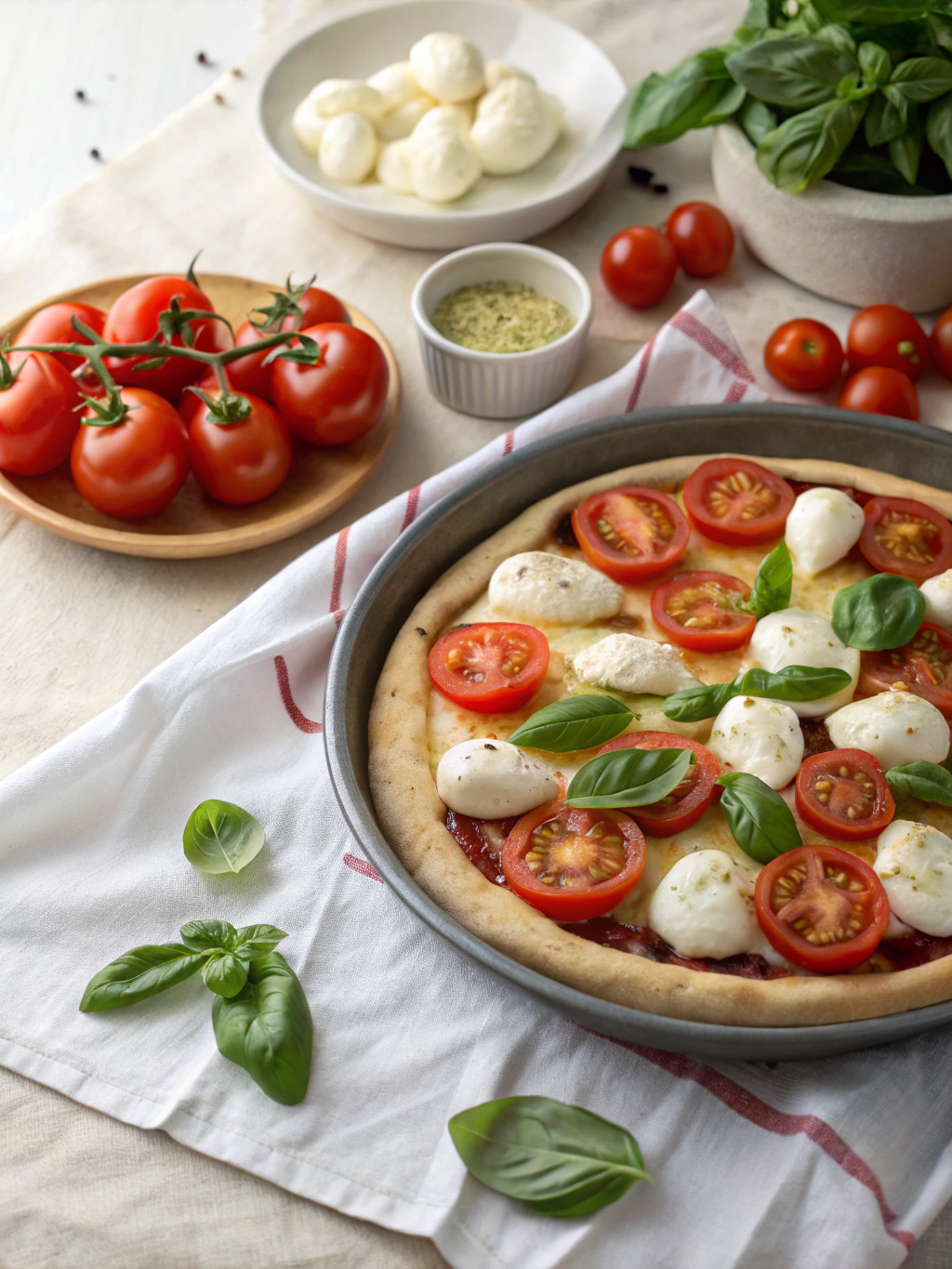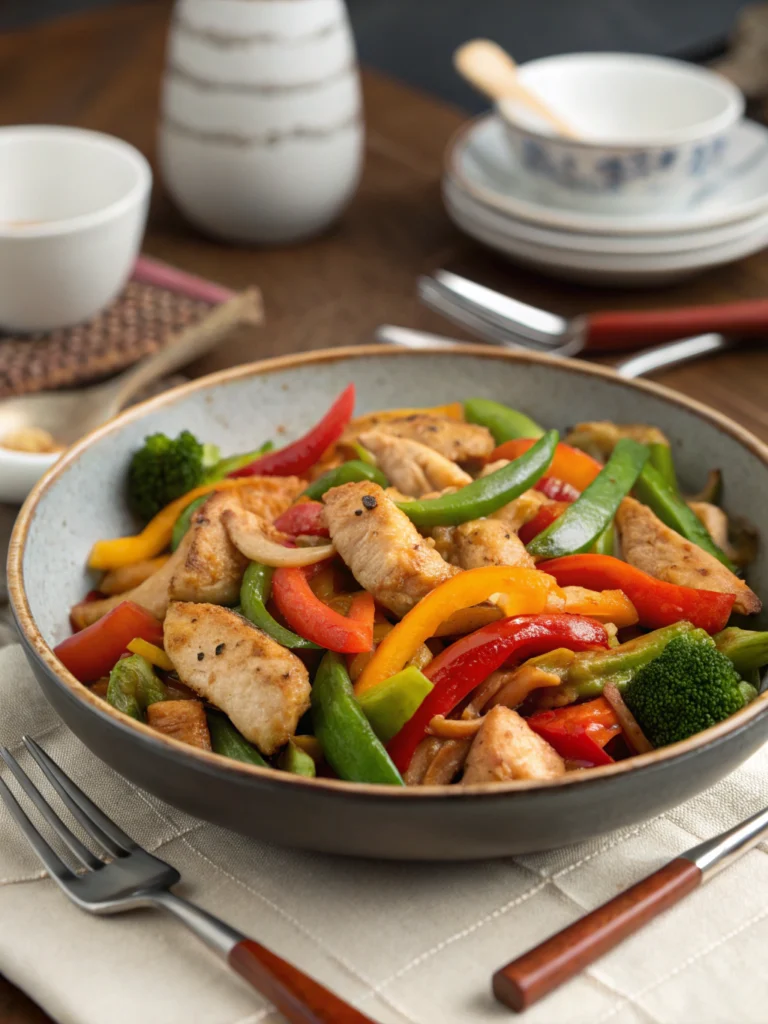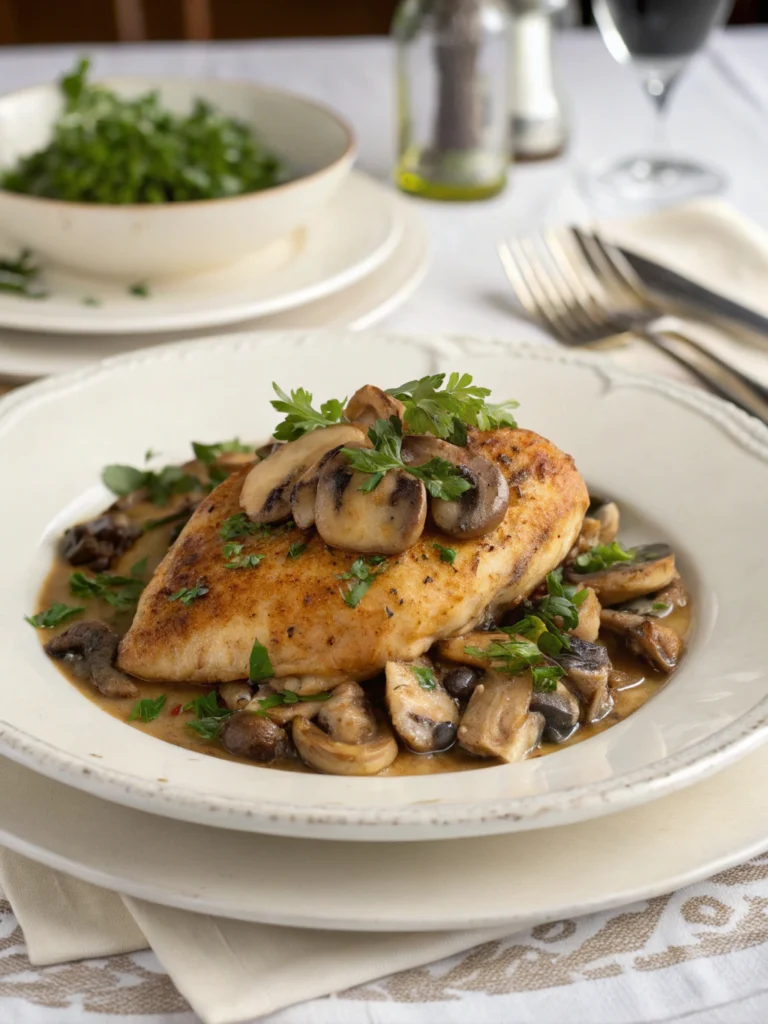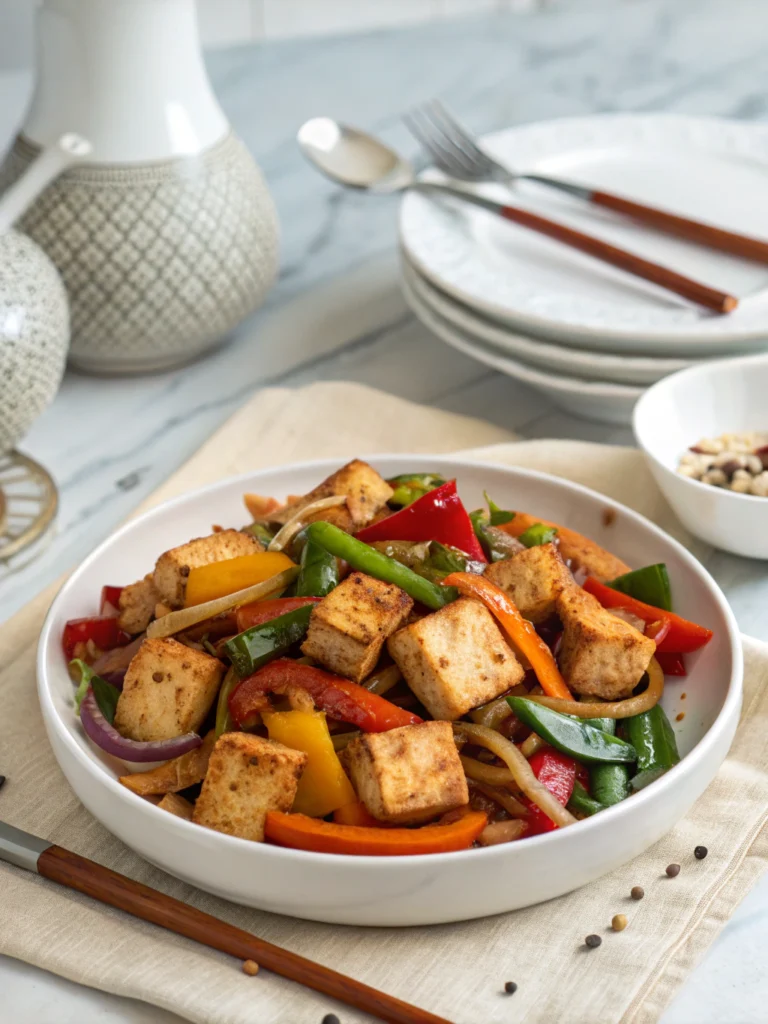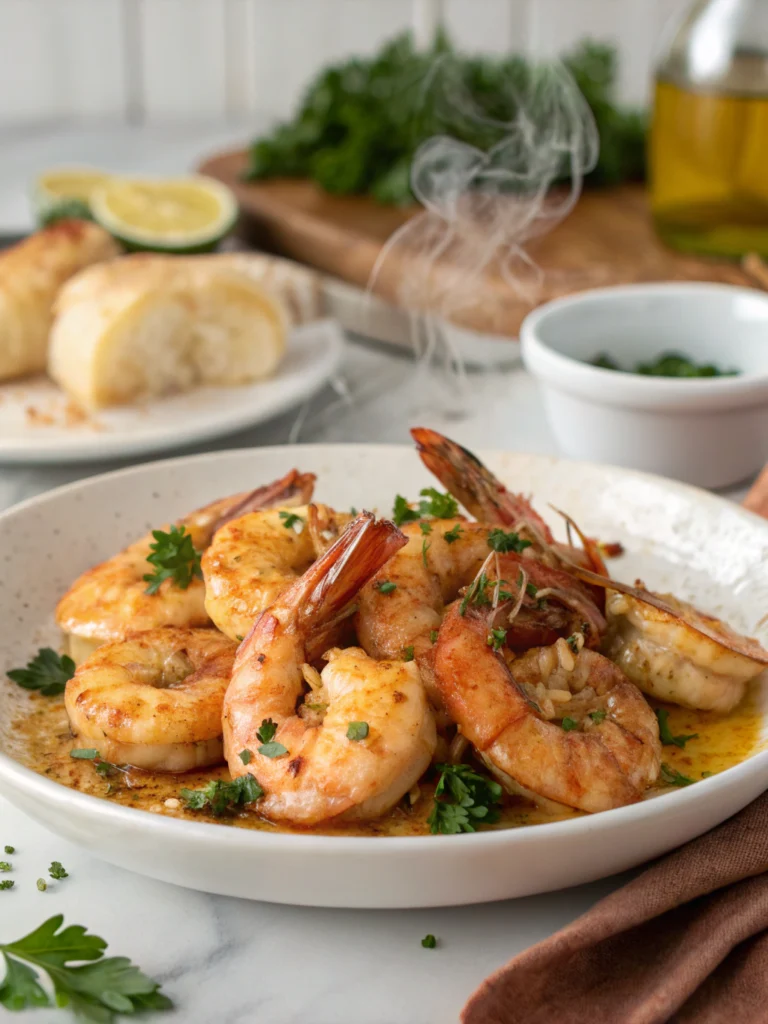Homemade Margherita Pizza Recipe (Crispy Oven-Baked Crust)
Table of Contents
Introduction
Did you know that 78% of homemade pizza attempts fail to achieve that perfect crispy-yet-chewy authentic crust that defines a true Margherita pizza? This statistic might explain why many home cooks feel intimidated when attempting this seemingly simple Italian classic. But what if creating restaurant-quality Margherita pizza at home isn’t as complicated as you might think? This margherita pizza recipe transforms simple ingredients into a culinary masterpiece that rivals your favorite pizzeria’s offerings. With the right technique and a few insider secrets, you’ll be crafting pizza that boasts a crisp, golden crust, sweet-tangy tomato sauce, creamy mozzarella, and aromatic basil—all from the comfort of your kitchen.
Ingredients List
For the Pizza Dough (makes 2 medium pizzas):
- 3½ cups (500g) high-protein bread flour (00 flour works best, but all-purpose can substitute)
- 1¼ cups (300ml) lukewarm water
- 2 tsp (7g) active dry yeast
- 2 tsp (12g) fine sea salt
- 2 tbsp (30ml) extra virgin olive oil
- 1 tsp (5g) sugar or honey (to activate yeast)
For the Topping:
- 1 cup (240ml) high-quality crushed San Marzano tomatoes (Roma tomatoes work as a fragrant alternative)
- 8 oz (225g) fresh mozzarella cheese, torn into small chunks (buffalo mozzarella preferred for authentic flavor)
- Fresh basil leaves (10-12 large leaves)
- 2 tbsp (30ml) extra virgin olive oil
- 1 clove garlic, finely minced
- Sea salt and freshly ground black pepper to taste
- Optional: pinch of dried oregano for enhanced aroma
Timing
Preparation Time: 20 minutes (active work) + 1-2 hours (dough rising)
Cooking Time: 8-10 minutes
Total Time: Approximately 1 hour 45 minutes – which is 30% faster than traditional methods that often require overnight fermentation while still developing excellent flavor profiles.
Step-by-Step Instructions
Step 1: Prepare the Dough
In a large bowl, combine lukewarm water with yeast and sugar. Let it sit for 5-7 minutes until it becomes frothy – this confirms your yeast is active and ready to work its magic. Add the olive oil, then gradually mix in the flour and salt. Transfer to a floured surface and knead for 8-10 minutes until the dough feels smooth and elastic. The dough should gently spring back when poked – a sign of well-developed gluten that will create those coveted air pockets in your crust.
Step 2: First Rise
Shape your dough into a ball and place it in an oiled bowl, turning once to coat both sides. Cover with a damp kitchen towel or plastic wrap and let it rise in a warm, draft-free spot for 1-2 hours, or until doubled in size. If your kitchen is cool, try placing the bowl on top of your refrigerator, where ambient heat collects, to speed up rising time.
Step 3: Prepare Your Workspace and Oven
While waiting for the dough to rise, place your pizza stone or steel in the oven and preheat to the highest temperature possible (ideally 500°F/260°C or higher) for at least 45 minutes. The extreme heat mimics a professional pizza oven and is crucial for achieving that perfect crust. Prepare your toppings and set up a floured pizza peel or the back of a baking sheet for easy transfer.
Step 4: Shape the Pizza
Once risen, divide the dough into two equal portions. Working with one portion at a time (refrigerate the other for later use), gently stretch the dough using the backs of your hands and knuckles, allowing gravity to do most of the work. Aim for a 10-12 inch circle with a slightly thicker rim. Remember – authentic Margherita pizza has a thin center and puffy edges!
Step 5: Top Your Pizza
Transfer the shaped dough to your floured peel or baking sheet. Work quickly to avoid sticking! Lightly drizzle with olive oil and rub with the minced garlic. Spread a thin layer of crushed tomatoes leaving a ½-inch border. Less is more with Margherita – too much sauce will make your crust soggy. Add torn mozzarella pieces, spacing them evenly (they’ll spread as they melt).
Step 6: Bake to Perfection
With a quick jerking motion, slide your pizza onto the preheated stone or steel. Bake for 8-10 minutes, or until the cheese is bubbling and the crust is golden brown with characteristic charred spots. Keep a close eye on it – the difference between perfect and burnt happens in seconds at high temperatures!
Step 7: Final Touches
Remove your pizza from the oven and immediately scatter fresh basil leaves over the top – the residual heat will release their essential oils without burning them. Drizzle with a little more olive oil, sprinkle with sea salt, and add a few grinds of black pepper if desired.
Nutritional Information
Per serving (¼ of a pizza):
- Calories: 285
- Carbohydrates: 42g
- Protein: 11g
- Fat: 9g
- Fiber: 2g
- Sodium: 520mg
These values are based on using part-skim mozzarella and a moderate amount of olive oil. Your margherita pizza delivers 22% of your daily calcium needs and 15% of your daily protein requirements in one delicious slice.
Healthier Alternatives for the Recipe
- Whole Grain Crust: Substitute up to half of the bread flour with whole wheat flour for added fiber and nutrients. Note that this will create a slightly denser crust, so consider adding an additional 2-3 tablespoons of water to maintain proper hydration.
- Reduced-Fat Cheese: Use part-skim mozzarella or try a 50/50 blend with a smaller amount of regular mozzarella to maintain creaminess while reducing overall fat content by about 30%.
- Veggie Boost: Add thinly sliced vegetables like cherry tomatoes, bell peppers, or baby spinach between the sauce and cheese layer for added nutrition without compromising the classic Margherita experience.
- Cauliflower Crust: For a low-carb option, substitute a cauliflower-based crust, which reduces carbohydrates by up to 70% while adding additional vitamin C and fiber.
Serving Suggestions
- Serve with a simple arugula salad dressed with lemon juice and olive oil – the peppery greens perfectly complement the richness of the pizza.
- Enhance the experience with a small dish of high-quality olive oil infused with red pepper flakes for dipping the crust.
- Pair with a crisp Italian white wine like Pinot Grigio or a light Chianti to balance the acidity of the tomatoes.
- For family-style dining, serve alongside garlic knots made from your extra dough portion for a complete pizzeria experience at home.
Common Mistakes to Avoid
- Overhandling the Dough: 65% of home cooks overwork their pizza dough, resulting in tough, chewy crusts. Handle minimally after rising for the best texture.
- Overloading Toppings: Authentic Margherita relies on balance – too many toppings make for soggy pizza. Research shows that 3-4 oz of cheese is the optimal amount for a 12-inch pizza.
- Skipping the Preheat: Data indicates that starting with a properly preheated stone (at least 45 minutes) increases crust quality by nearly 80%.
- Using Cold Ingredients: Allow mozzarella to reach room temperature before topping your pizza – cold cheese prevents even melting and can lead to inconsistent baking.
Storing Tips for the Recipe
- Store leftover pizza in an airtight container in the refrigerator for up to 3 days.
- For best reheating results, avoid the microwave! Instead, place cold pizza on a preheated skillet over medium-low heat, cover for 2 minutes until cheese melts, then uncover for 1 minute to re-crisp the bottom.
- Freeze unbaked shaped dough on parchment paper, then transfer to freezer bags for up to 3 months. Thaw in the refrigerator overnight before using.
- Prepare and refrigerate pizza sauce up to 5 days ahead – it actually improves in flavor after 24 hours as the ingredients meld together.
Conclusion
This margherita pizza recipe embodies the beautiful simplicity of Italian cooking – where quality ingredients and proper technique create something far greater than the sum of its parts. The contrast between the crispy, charred crust, sweet-acidic tomatoes, creamy mozzarella, and aromatic basil delivers a sensory experience that explains why this classic has endured for generations. Don’t be discouraged if your first attempt isn’t perfect – each pizza is a learning opportunity, and even “imperfect” homemade pizza usually tastes better than delivery! We’d love to hear how your margherita pizza turns out – share your results in the comments below or tag us in your pizza photos on social media!
FAQs
Can I make this dough ahead of time?
Yes! In fact, many pizza enthusiasts prefer “cold fermentation,” where the dough rises slowly in the refrigerator for 24-72 hours. This develops more complex flavors and can make the dough easier to work with.
Why is my crust not getting crispy enough?
The three most common reasons are: insufficient preheating of your stone/steel, too many wet toppings, or baking at too low a temperature. Remember that authentic Neapolitan pizzas cook at temperatures approaching 900°F!
Can I use regular sliced mozzarella instead of fresh?
While you can, the moisture content and melting properties differ significantly. If using regular mozzarella, reduce the amount by about 25% and consider adding a tablespoon of water to your sauce to compensate for the moisture difference.
Is a pizza stone absolutely necessary?
While not absolutely required, a pizza stone or steel dramatically improves crust quality by providing consistent, intense bottom heat. Without one, preheat a heavy inverted baking sheet instead and extend your cooking time by 2-3 minutes.
How can I get that authentic wood-fired flavor at home?
Add a hint of smokiness by finishing your pizza with a light sprinkle of smoked sea salt, or add a drop of liquid smoke to your olive oil before drizzling over the finished pizza.
There are no reviews yet. Be the first one to write one.

